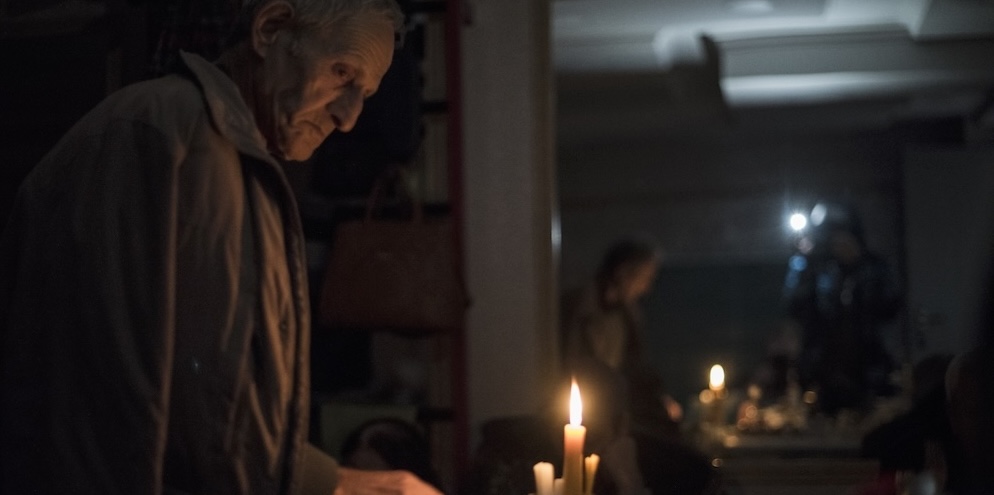In December 1991, the Soviet Union collapsed. My family had left just a few months earlier to immigrate to Israel from Leningrad—which reverted post-collapse to its pre-revolutionary name of St. Petersburg. For many who stayed behind, the experience was disorienting to an extreme degree. The world as they had known it simply ceased to exist overnight. For her Nobel Prize–winning Secondhand Time, Belarusian writer Svetlana Alexievich interviewed people of different ages and professions, examining the epidemic of despair and suicide among those who could not fathom the meaning of their lives after communism. At least they did not have war to contend with on top of this existential and societal crisis. But nearly 2,000 miles away from my home city, in rural Nagorno Karabakh, the story was different.
In the early 1990s, Armenian villages in Nagorno Karabakh, the mountainous region on the border of Armenia and Azerbaijan, found themselves targets of intense attacks from Azerbaijan, determined to annex the territory. The conflict had been ramping up since 1988, and the dissolution of the USSR intensified the aggressors’ boldness. The war that followed was characterized by blatant attacks on civilians: outright bombings of villages, obliterating the small homes with their unsuspecting inhabitants within; snipers taking shots regularly at civilian cars driving down the already perilous mountainous roads; an overall destruction of a previously stable and simple existence, displacing thousands of residents from the region, whether temporarily or forever.
At least, one could say, these last ones lived. No such luck for the young woman in the backseat of a car, holding the tray of freshly made baklava, riding with her brothers to a family gathering. A sniper killed her with a bullet through the windshield. Why would anyone do that, one cannot help but wonder. Such, though, is the nature of war—brutal, unforgiving, dehumanizing.
How does one go on living after such devastating trauma, after the loss of loved ones in one’s own family and in the close-knit community around? How can one recover the delight in life and love after this overwhelming tragedy that left no family untouched? In her new short story collection, To Go On Living, Armenian writer Narine Abgaryan attempts to answer this question the only way she knows—through storytelling. The quest is personal and devastating: “To write about war means almost destroying any hope within yourself. Like staring death in the face while trying not to avert your eyes. Because if you do, you will have betrayed your own self. I tried my best. I am not sure that I have succeeded.”
If success means bringing the reader to experience a vibrant world, lost and only partly regained, Abgaryan has succeeded. The stories are short—31 of them crammed into a thin volume—her narration style matter-of-fact and simple. Short descriptive sentences roll on, one after the other, reminiscent of the folk narrators who traditionally told such stories orally for entertainment. One can imagine the storyteller in action, tone of voice at times somber and quiet, at others joyful and exuberant, hand gestures adding to the words throughout.
The formulaic nature of the stories likewise echoes folk tradition. There was once a happy family—a mother, a father, perhaps the elderly parents of one of them, some children of different ages, and maybe a cow and other animals in the barn attached to the home. Their lives were simple, in no way extraordinary. They took care of their home, planted crops and harvested them in due time, squabbled and teased each other as families do, baked baklava for special occasions, swept the floor regularly (and fought about whose turn it was to do it next), knit socks, and made plenty of basic foods and tea every day.
There is no real plot, perhaps—in the sense that there is no tension beyond the mundane in each story at first. An unexpected pivot coming from one sentence to the next is the only clue that we have moved from the “before” to the “after.” It all seems so artificial, a reminder that war was not supposed to be part of this story, but there it is. The intrusion of war spares no one. The few who are left behind now are trying to pick up the pieces, trying to find a way—and a reason—to go on.
And go on they do—they are not subject to melancholy, suicidal despair of the sort Alexievich relates among post-Soviet city dwellers. Abgaryan’s stories, rather, show people as determined and hardy as the mountains they call home. The woman who lost a child and both her legs to an explosion gets married again and has a new child. The man who had to dig his mother’s body from her home destroyed by a shell now drives an extra-loud truck and cannot abide any silence—as all his neighbors know. Person after person, neighbor after neighbor, each one knows the tragedies of the others; each one feels the losses viscerally and expresses compassion and sorrow for the others in varied ways. Not one is left unseen in the “after.”
They recover some happiness, most of them. And yet, it is the happiness of Job. Can one ever just replace the loved ones taken away? A new child or husband or wife does not replace the one killed. Any new joys will always be marred by memories of losses, even as those grow more distant year after year. And so absences define these villagers’ lives—once the “after” has happened, the “before” is nothing but pale, stinging memories. Only stories remain of the beautiful young girl, the laughing child, the elderly woman whose baked goods were legendary, the doting grandfather killed before he could get down to the bomb shelter during a shelling.
But presences matter, too—most of all, the presence of the others in the village, without whom continuing would have been impossible, not only in the practical sense, but perhaps even more so in the metaphysical. Their trauma is collective, the tragedy belongs to them all, but so does the determination to support each other. Amid their suffering, Abgaryan’s villagers have taken on the characteristics of saints—spared from death once, they are eager to lay down their lives for others around them now. This has become who they are, how they live.
There is something reminiscent of Wendell Berry’s Port William stories and novels in this viscerally powerful collection. Berry, too, writes of people who belong to their small Kentucky town’s membership—a covenant community of those who love the town and the rest of its inhabitants. “Membership” is not an official title, yet it brings responsibilities of love and care that are at times deeper than anything we would expect even of flesh and blood. Most of Berry’s characters have not experienced war, yet they find their love for a simple rural existence under attack by the modern and ruthlessly modernizing world. They lose parts of themselves to this world—in the case of one character his right arm, lost to a farm machine. But when they find comfort, it is in the membership they have with one another and, in some transcendent sense, with the town they love so dearly.
The people whose stories Abgaryan weaves together belong to a similar membership of love for each other and for the place they call home. We see, furthermore, an intricate web of storytelling through which the survivors try to maintain the memory of those gone. The writer tells their stories in this book, certainly, but the survivors, too, tell these stories to themselves while walking along the road to the liturgy for the dead, while doing laundry, while baking bread. “After all, our conscience speaks to us in the voices of the departed. Just tune out the external noise, and you will hear them.” So Abgaryan concludes one story, but this conclusion would have been just as apt for all the rest. The membership, I realized upon concluding To Go On Living, includes the dead still, just as much as the living, in an act of resistance that defies the otherwise neat division of time and space into the “before” and the “after.”
The war was a “broken embrace,” taking loved ones forever from their families’ grasp. The ones left behind need all three heavenly virtues to keep going—faith, hope, and, most of all, love. Faith in God’s promises that justice, while not given them here, will be theirs someday. Hope for a future that will bring joy again. And love for people and this place they all call home, even in the midst of devastation. Toward the end of her epilogue, Abgaryan relates that her sister recently had a baby boy. This birth—a new life!—felt at last as a restoration of the broken embrace, bringing hope for the future that felt elusive until that very moment.
Abgaryan concludes: “Life is fairer than death, and that’s what encapsulates its unbreakable truth. It is necessary to believe this in order to go on living.” The power of her stories lies in bringing this truth to the fore.

